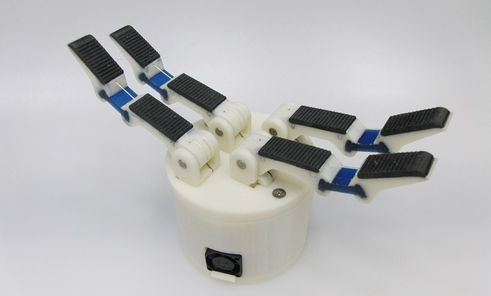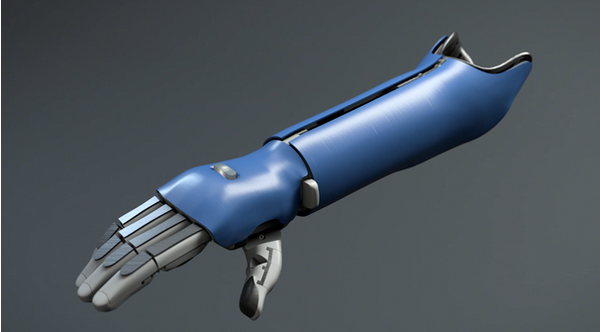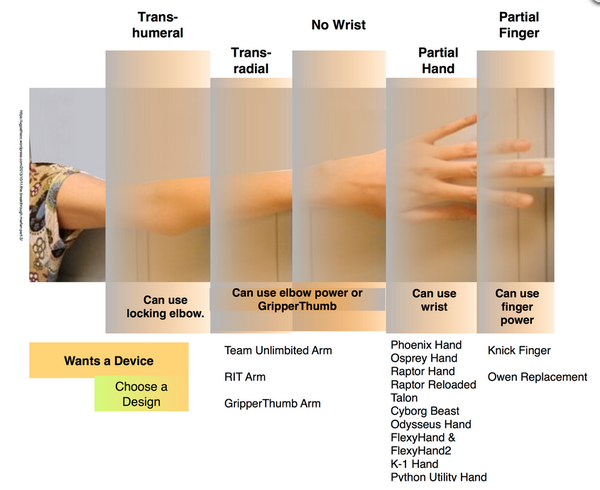Open Source Prosthetics
The Hidden Revolution
ByOpen source software and hardware quietly transforms the field of human prosthetics.
Not long ago, the use of open source was news. Today, it has become so routine that it is hardly even mentioned. However, the fact that open source software and hardware are on the edge of revolutionizing an entire industry is another matter altogether. Yet that is what is happening in the research and development of human prosthetics and augmentation. In the last eight years or so, open source has quietly become a dominant influence in this field, and now it is poised to completely redefine the market.
Currently, human prosthetics and augmentation are concerned largely with the replacement of lost limbs – especially hands – and the development of exoskeletons for lost mobility. Yet potential future uses are extensive. In 2013, Open Health News noted that, “Human augmentation technologies have the potential to enhance our innate human abilities in many ways. For example, it could be used to replace missing limbs or correct physical disabilities. In fact, some of the latest prosthetic devices have now reached the stage where they offer equivalent or slightly improved functionality over human limbs.” Although current development focuses on medical uses, in the future they could also be used for combat, to assist the elderly, and to create wearable machines that could be used in firefighting and disaster relief, and, more mundanely, in nursing and in warehouses. These uses are becoming increasingly practical, not simply due to the use of open source, but also due to recent developments that have made open hardware more practical than ever before.
The Rise of Open Source
Human prosthetics and augmentation can benefit from open source in many of the same ways that other industries do. With open source, development can be piggybacked on top of earlier efforts in the field, reducing the amount of research required for a profit and resulting in a quicker time to market. In addition, since openness is already commonplace in research, open source can help academia and business to cooperate more efficiently. Thanks to open source, development costs are now so reduced that students and hobbyists can develop prosthetics on their own.
The greatest benefit is reduced cost. For example, where a prosthetic arm can cost tens of thousands of dollars – largely because each prosthetic is a custom job – a company like Open Bionics can produce a prosthetic in a matter of weeks for a few thousand Euros, at least a tenth of the cost of a comparable proprietary prosthetic. As a result, prosthetics become a possibility for the poor or for developing nations in a way that they were not before. In fact, because the demand for affordable prosthetics is so great, the fact that prototypes often have yet to be medically certified does not discourage volunteers from testing the results.
Two technical developments in the last decade have further enhanced the advantages of open source. First, the development of single-board microcontrollers costing under $50 apiece has reduced costs still further. Although these boards have limited functionality, the use of several together can still make for a highly functional, low-cost device. Arduino boards are particularly popular in the field, with advantages that include cross-platform support, an IDE for writing code and flashing firmware, a simple but extensible programming language, and a large, diverse developer community.
Just as importantly, for an initial setup of a few thousand dollars, 3D printers allow the design and production of cheap parts in a way that was never possible before. Many open source prosthetics include the schematics for printing parts that not long ago could only be produced by a commercial manufacturer. With 3D printers, research can be accelerated because both modifications and replacement parts can be made in a matter of hours. Because of such technical advantages, the development of prosthetics has thrived to a degree that would have been impossible only a decade ago.
Some Players in the Field
Open source prosthetics are being developed by amateurs, academics, and companies. The interactions are so close that at times the distinctions almost disappear, with amateurs contributing resources and design modifications for general use, and academics becoming involved in business development.
At the entry level, sites like Instructable.com, where teachers post lesson plans and class projects, or Hackaday.io, a site for do-it-yourselfers, post instructions for prosthetics such as pen holders, sensors for heat and touch, or even exoskeleton limbs that can be built for under $100 (especially with used parts). Such devices are mostly learning tools, but individuals are also making serious contributions to the general pool of solutions. For example, Albert Manero, who was a guest at Penguicon 2015, is responsible for plans for myoelectric systems that allow prosthetics to interact with the human nervous system.
One of the first and most influential academic centers for open source prosthetics is the Yale OpenHand Project. From the first, the project has worked “to advance the design and use of robotic hands designed and built through rapid-prototyping techniques in order to encourage more variation and innovation in mechanical hardware.” In practice, this has meant the development of four open source designs for artificial hands, as well as the means of attaching them to human wrists or arms. These designs have become the inspiration for other open source devices, both with and without modifications, as allowed by open source licenses (Figure 1).
In particular, the work done by the Yale OpenHand Project was the original foundation for Open Bionics, a company based in the United Kingdom. Dedicated to producing prosthetics with off-the-shelf components, Open Bionics publishes on its website source code, CAD designs, and schematics for 3D printing, and it is one of a handful of open source prosthetic developers whose products are medically certified. Its basic hands cost less than $100; its cosmetic hands cost less than $200 (Figure 2). in In 2016, designers from the company were involved with Konami in the production of a futuristic-looking arm for a game, based on one depicted in the video game Metal Gear Solid.
Many of the different development centers find a home in e-NABLE. Beginning with a movable hand designed by Ivan Owen for a cyberpunk convention, e-NABLE morphed from a Google group to an open source site with 8,000 contributors and chapters worldwide. Today, the site has become a repository for designs and schematics, as well as a collection of case studies, forums, and grant applications. The site attracts both end users and contributors of all expertise levels (Figure 3).
Open Source Obscurity
These instances are just a sampling of the wide range of activity in the development of open source prosthetics. Since the activity is so extensive, the question naturally arises: Why isn’t this branch of open source development better known? After all, the activity is hardly hidden. As with most open source projects, the development is largely done in the open.
Part of the reason may be that the field is relatively specialized and far removed from the practical concerns of home computing and networking that tend to dominate open source media coverage. Another part may be that it is relatively recent – less than a decade old, it was not anticipated to have emerged so rapidly. Even now, much of the development has only started to reach the point of product release, and many other results were not intended for commercial usage in the first place.
However, much of the reason is that the use of open source is not in itself news, except in a niche market. The general media might report that, in 2015, Robert Downey, Jr. presented a prosthetic arm to a disabled boy, but the coverage emphasizes the human interest in the story, making no mention of the role that open source played in the development of the device. It mentions Albert Manero, and the fact that the arm was developed for under $350, but not Manero’s open source contributions, let alone the network of amateurs and professionals that made the arm possible. However, even if open source has become commonplace, its ability to transform product development and the marketplace to such an extent is still worth acknowledging.
next page » 1 2
Subscribe to our Linux Newsletters
Find Linux and Open Source Jobs
Subscribe to our ADMIN Newsletters
Support Our Work
Linux Magazine content is made possible with support from readers like you. Please consider contributing when you’ve found an article to be beneficial.

News
-
Parrot OS Switches to KDE Plasma Desktop
Yet another distro is making the move to the KDE Plasma desktop.
-
TUXEDO Announces Gemini 17
TUXEDO Computers has released the fourth generation of its Gemini laptop with plenty of updates.
-
Two New Distros Adopt Enlightenment
MX Moksha and AV Linux 25 join ranks with Bodhi Linux and embrace the Enlightenment desktop.
-
Solus Linux 4.8 Removes Python 2
Solus Linux 4.8 has been released with the latest Linux kernel, updated desktops, and a key removal.
-
Zorin OS 18 Hits over a Million Downloads
If you doubt Linux isn't gaining popularity, you only have to look at Zorin OS's download numbers.
-
TUXEDO Computers Scraps Snapdragon X1E-Based Laptop
Due to issues with a Snapdragon CPU, TUXEDO Computers has cancelled its plans to release a laptop based on this elite hardware.
-
Debian Unleashes Debian Libre Live
Debian Libre Live keeps your machine free of proprietary software.
-
Valve Announces Pending Release of Steam Machine
Shout it to the heavens: Steam Machine, powered by Linux, is set to arrive in 2026.
-
Happy Birthday, ADMIN Magazine!
ADMIN is celebrating its 15th anniversary with issue #90.
-
Another Linux Malware Discovered
Russian hackers use Hyper-V to hide malware within Linux virtual machines.



